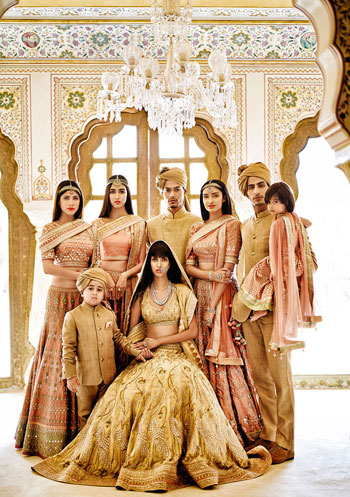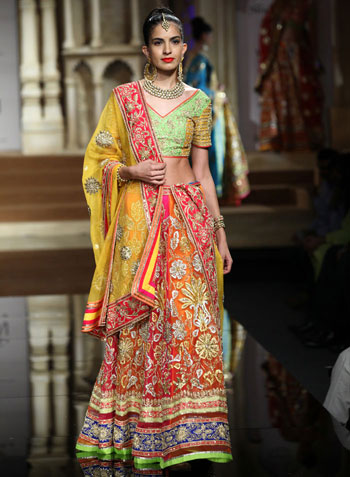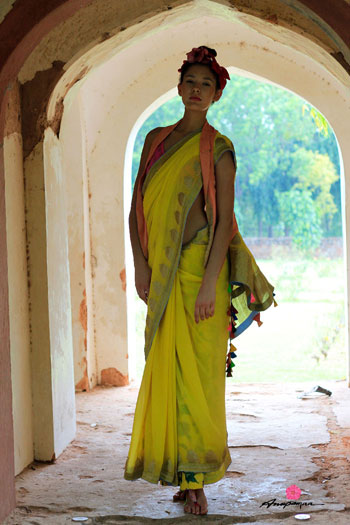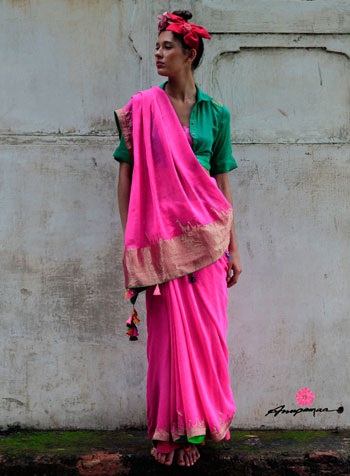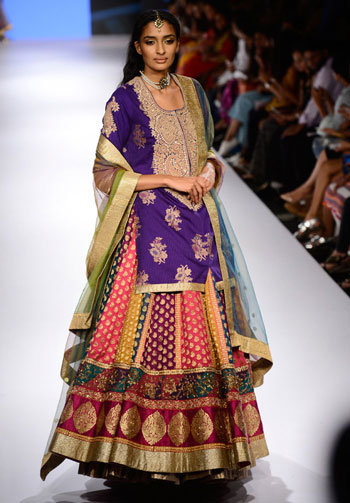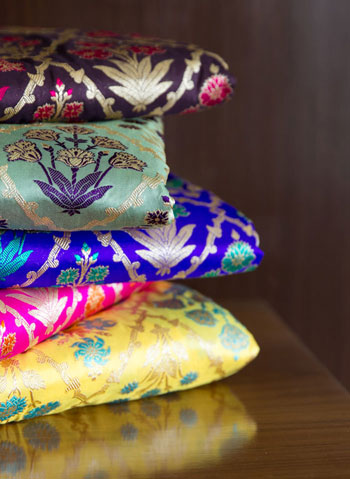The beautiful Banarasi weave is seeing a huge revival, backed by India’s best designers and the Indian government’s decision to support handlooms and the country’s talented craftsmen. Varanasi, from where the Banaras weave comes, is also Indian Prime Minister Narendra Modi’s constituency.
Everyone who is anyone in the world of fashion and luxury in India is making a beeline for Varanasi, or Banaras, which is famous as the oldest cities in the world, a gourmand’s paradise, and, more importantly, the city that gave birth to the exquisite Banarasi weave.
Anita Dongre design
Over the years, however, the Banarasi weave has lost favour, primarily because the newer generation of weavers doesn’t remember much of the design legacy of their forefathers and the textiles they often produce is stiff, unlike the ones their ancestors weaved: soft, malleable and beautifully hand-weaved.
Abu Jani- Sandeep Khosla
However, there may still be hope. There is a Banarasi renaissance of sort in the offing. Almost every Indian designer who works on revival of Indian textiles today works with the Banarasi weave. In the storm raised by ornate sari gowns and blingy lehngas that have become a staple of the Indian woman’s Diwali wardrobe and her trousseau, the bright, beautiful and bold weaves of the Banarasi silk and brocade saris had somewhere lost its lustre. “There was a time when no woman could think of her Diwali wardrobe, or her trousseau, without a Banarasi,” says designer Ritu Kumar. “But then the motifs and patterns got too traditional for the younger generation.”
Anupama-Dayal for Ekaya
So what is it now about the Banarasi weave and textile that’s forcing every designer worth their extravagantly priced haute couture to make their way to the humble homes of the once forgotten master weavers? To appeal to a generation that loves traditions sans the fuss, Kumar recently sent out an interesting version of the half-sari — a pink brocade Banarasi sari tucked in at the waist at one end, draped over the shoulder and worn with a churidaar for a look that speaks volumes about our ability to adapt our cultural moorings to the modern world. The city’s legacy of silks, brocade and gold-and-silver thread work have coalesced in Abu Sandeep’s fabulous multilayered collection, Varanasi, which was presented at the India Bridal Fashion Week in Delhi. “Banaras, or Kashi, is a city steeped in legend and mythology,” says Abu Jani. “The city has a rich weaving heritage that we are trying to leverage.”
The huge interest in this ancient weaving technique probably has something to do with the fact that Varanasi is also the constituency of Prime Minister Narendra Modi. “He has brought the focus back on Varanasi and on the famed silk and brocade weavers, who have lived in sheer neglect,” says designer Rahul Mishra.
Ritu Kumar
In 2013, the socially conscious New York fashion label Maiyet and the Taj Hotels Resorts and Palaces helped reinvigorate this ancient skill by employing some weavers and inviting tourists to visit them as they worked. About 800 people have taken Maiyet’s tour since; more than 650 have gone on the tour organised by Taj.
And now designers, and stores like Ekaya in New Delhi, are reinterpreting the ancient weave and the gossamer fabric, which is woven by hand on long wooden looms, for the millennials. Ekaya works with designers like Rajesh Pratap Singh and Anupama Dayal to create modern iterations saturated with pop colours, or include motifs like the fish or the horse that were never a part of the Banarasi design. “Ekaya blends ancient art with an eclectic vision to emphasise hand-done workmanship and lend it the necessary impetus,” says owner Bharat Shah.
In August last year, BJP politician and designer Shaina NC brought together India’s top designers — Manish Malhotra, Ritu Kumar, Rohit Bal and Rina Dhaka, along with Mishra — for a Banarasi textile project that was exhibited in Mumbai’s Bhau Daji Lad Museum. Mishra, who showcased lehngas crafted out of the ornate Banarasi brocade at the India Fashion Week, is working on using the weave for his Paris Fashion Week collection. “I want to showcase Banarasi silk at international fashion weeks so that it gains greater international exposure. I feel handloom adds a lot of character to me as a designer.”
The government’s support has also given the Benarasi weave a major fillip. The ‘India Handloom’ brand portal, an initiative launched by Prime Minister Narendra Modi last year to promote textiles created in India, reveals that Varanasi has 80,000 looms and around a 100,000 weavers. “The government is committed to raising the market positioning of handloom products and increasing the wages of the weavers,” the Textile Secretary, Rashmi Verma had said during the launch of the portal. One of its biggest roles will be to verify the genuineness of a brand through unique registration numbers on the label, and also identify retail stores and e-commerce platform on which ‘India Handloom’ branded products can be retailed.
Saris by Swati & Sunaina
In 2009, ‘Banaras Brocades and Sarees’ secured Geographical Indication (GI) rights, a notification that covered silk brocades, textile goods, silk saris, dress materials and silk embroideries. The GI would continue for 10 years, on a renewable basis. In 2014, Prime Minister Narendra Modi laid the foundation stone for a Trade Facilitation Centre (TFC) — a 200-crore project spread over an eight-acre space that promises advisory services, as well as a skill development centre to encourage the next generation to carry forth the legacy. Banaras is also part of the 28 weaver service centres functioning across the country. In the first phase, Banaras is being strengthened by introduction of computer-aided textile design software, the setting-up of upgraded looms and accessories, and the development of display-cum-visitor centres.
Clearly, everyone has Banaras on their minds, and for good reasons.

